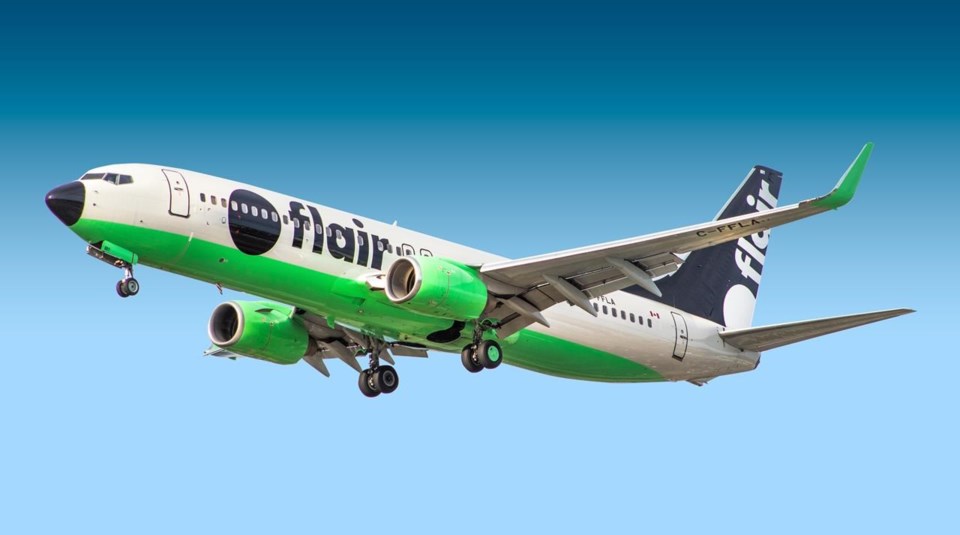Flair Airlines CEO Stephen Jones says his budget carrier is at last running a smooth operation propelled by high passenger numbers, despite "growing pains" at the debt-laden company that's still striving to gain consumer confidence.
In an interview, the chief executive said Flair topped the list of Canadian airlines in on-time performance over the summer as well as in load factors, with planes 90 per cent full on average last month.
ŌĆ£We're very far from perfect,ŌĆØ Jones qualified. ŌĆ£WeŌĆÖve had tons of growing pains ŌĆö some operationally, some financially, some CTA."
The latter refers to the Canadian Transportation Agency, which prompted Flair last year to rejig its board and revoke shareholder rights from key investor 777 Partners in order to comply with rules around domestic ownership.
Moreover, Flair must continue to make payments of more than US$7 million per month on its 21 Boeing 737 plane leases and manage loans amounting to between US$200 million and US$300 million, Jones said.
ŌĆ£We do pay expensive debt," he said, citing rates of 18 per cent on loans from 777 Partners, the Miami-based company that owns one-quarter of the airline.
ŌĆ£No one else was standing there willing, during COVID and during high oil prices, to say, ŌĆśYou know what, we believe in the vision of a low-cost carrier in Canada, here's some 17 per cent money.ŌĆÖ
ŌĆ£The balance sheet is not in great shape," Jones added, but noted the interest is "non-cash" ŌĆö no monthly payments required ŌĆö and merely adds to the principal. "At some point there will be some form of reckoning, whether it's a restructure or whatever."
Despite the debt burden, Flair's performance improvements mark a sharp shift from the frequent delays and frustrations that shrouded the Edmonton-based airline as recently as March, when a leasing company seized four its planes over claims of missed payments.
A Facebook page dedicated to Flair passenger woes continues to log issues, but features fewer complaints than a year ago, when travel chaos descended on a sector unprepared for the surge in post-pandemic demand.
Now, Flair plans to double down on its split emphasis of domestic trips in the summer and sun routes in the winter. Roughly four of every five flights will be within Canada a year from now compared with 60 to 70 per cent currently. And in the coldest months, more than three-quarters of its trips will be to the U.S. Sunbelt, Mexico and the Caribbean compared with 40 per cent last winter, Jones said.
Flair can also breathe a little easier as budget carrier Swoop prepares for shutdown and incorporation into WestJet, its parent company, following a fierce rivalry over routes and fares.
"We'd go into a market, Swoop would be put on top ŌĆö same time of day, same day of week ŌĆö and just dump capacity on top of us. If we ultimately left because it was unsustainable, then they left as well," Jones said.
ŌĆ£We are now shifting away from what has been a sort of brutal domestic fight."
The operational improvements help too, he said, adding that a more stable network will allow Flair to expand its fleet to 26 planes next year from 21.
ŌĆ£WeŌĆÖre actually running a decent airline now," he said. ŌĆ£More and more, people are just connecting to the idea that they can travel around Canada affordably and have some fun."
Barry Prentice, who directs the University of Manitoba's transport institute, said it's the shoulder seasons of fall and spring that can hurt an airline's bottom line, especially for leisure-focused airlines like Flair and Lynx Air, a low-cost carrier that launched last year in a now-crowded market.
Traditionally, fewer vacationers board planes in those months, and the larger carriers have higher-margin business travellers to fall back on ŌĆö even if the corporate jet set has been slow to return with the rise of video conferencing.
"A lot of people, if they have a choice between flying with one of the big airlines or someone that they aren't quite as confident in, they'll take the big one," Prentice said.
"And if there's a problem, depending how hard they're pushing their fleet, they don't have the extra capacity to fill in," he said, referring to low-cost airlines' much smaller aircraft tallies.
Nonetheless, Prentice views the budget carrier business model of plane leases over purchases as allowing greater flexibility to respond to market conditions by cutting back in lean times.
For its part, Flair has arranged to hand over two of its aircraft to low-cost Australian carrier Bonza Aviation for the winter ŌĆö summertime Down Under ŌĆö and retrieve them on top of two more from Bonza in the summer.
ŌĆ£The issue that always confronts the airlines is the market demand. When things are going great, theyŌĆÖre doing really well, and when the economy starts to falter, they really stumble," Prentice said.
This report by The Canadian Press was first published Aug. 22, 2023.
Christopher Reynolds, The Canadian Press




